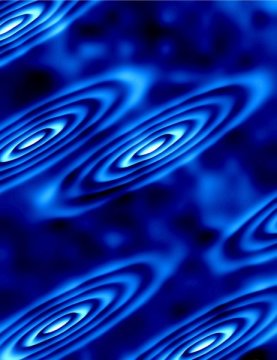THE SPACE FOR SHARING KNOWLEDGE FOR EMPOWERING MINDS
New classes of electron orbits discovered
Date : October 4, 2016
Source: American Institute of Physics (AIP)
Summary:
Phenomena like solar flares and auroras are consequences of magnetic reconnection in the near-Earth space. These “magnetic reconnection” events are akin to magnetic explosions that accelerate particles as they rapidly change the topology of the magnetic field lines. Researchers have used a new Particle-In-Cell (PIC) simulator to understand how magnetic reconnection works for the tenuous plasma surrounding our Earth and have identified new classes of electron orbits that help scientists understand the characteristics of the fast jets of electrons that stream from the reconnection region.
Unusual quantum liquid on crystal surface could inspire future electronics
Date: October 21, 2016
Source: Princeton University
Summary:
For the first time, an experiment has directly imaged electron orbits in a high-magnetic field, illuminating an unusual collective behavior in electrons and suggesting new ways of manipulating the charged particles.
Strange electron orbits form on the surface of a crystal in this image created using a theoretical data model. These orbits correspond to the electrons being in different ‘valleys’ of states, yielding new insights into an area of research called ‘vallytronics,’ which seeks alternative ways to manipulate electrons for future electronic applications.
Credit: Department of Physics, Princeton University

Gamma ray camera offers new view on ultra-high energy electrons in plasma
Date: October 28, 2016 Source: American Physical Society Summary:
A new kind of gamma ray camera has been invented that can image beams of energetic electrons inside ultra-hot fusion plasma, report scientists.
Credit: General Atomics
Researchers at General Atomics (GA) have invented a new kind of gamma ray camera that can image beams of energetic electrons inside ultra-hot fusion plasma.
The device is used in ongoing global research that is developing fusion into a new clean energy source. Turning fusion fuel into extractable energy requires it to be hotter than the center of the sun, hence in the plasma state. If the shutdown phase of operation is not controlled well, released magnetic energy can drive a population of electrons to relativistic speeds. If this population is not controlled, the electrons impact the inner walls of the plasma chamber, leading to material damage.
A team of researchers is working to better understand the properties of these electrons at the DIII-D National Fusion Facility operated by GA in San Diego for the U.S. Department of Energy. They designed and built a Gamma Ray Imager to capture the image of these particles.
The Gamma Ray Imager works on the principle of a standard pinhole camera except that it is made of lead and weighs 420 pounds (190.5 kilograms). The imager actually records images of equally energetic gamma rays that are emitted by the electrons, and the lead is necessary to achieve a good focus. These gamma ray measurements provide information about the energy, direction, and quantity of electrons in the relativistic population, giving researchers an unparalleled view of how the energetic electrons evolve and interact with the fusion plasma.
“This system allows us to see with unprecedented detail how different plasma properties can mitigate these electrons,” said Dr. Carlos Paz-Soldan, the scientist who led the first experiments utilizing the new camera. The results, to be presented at the American Physical Society Division of Plasma Physics conference Oct. 31-Nov. 4, demonstrate experimentally that radiation “reaction” forces are able to sap the highest energy electrons while collisions with other electrons are most effective at low energy.
These measurements imply that energetic electron control is not one-size-fits all, and that different energies require different control strategies.
With the new measurements, scientists can compare the behavior of the electron populations to theoretical models being developed by research teams worldwide. These models are, in turn, crucial to predict how the electron populations will behave in new reactors, such as the ITER tokamak now under construction in Cadarache, France, and thus ensure they can be adequately controlled.
Source:Materials provided by American Physical Society.
